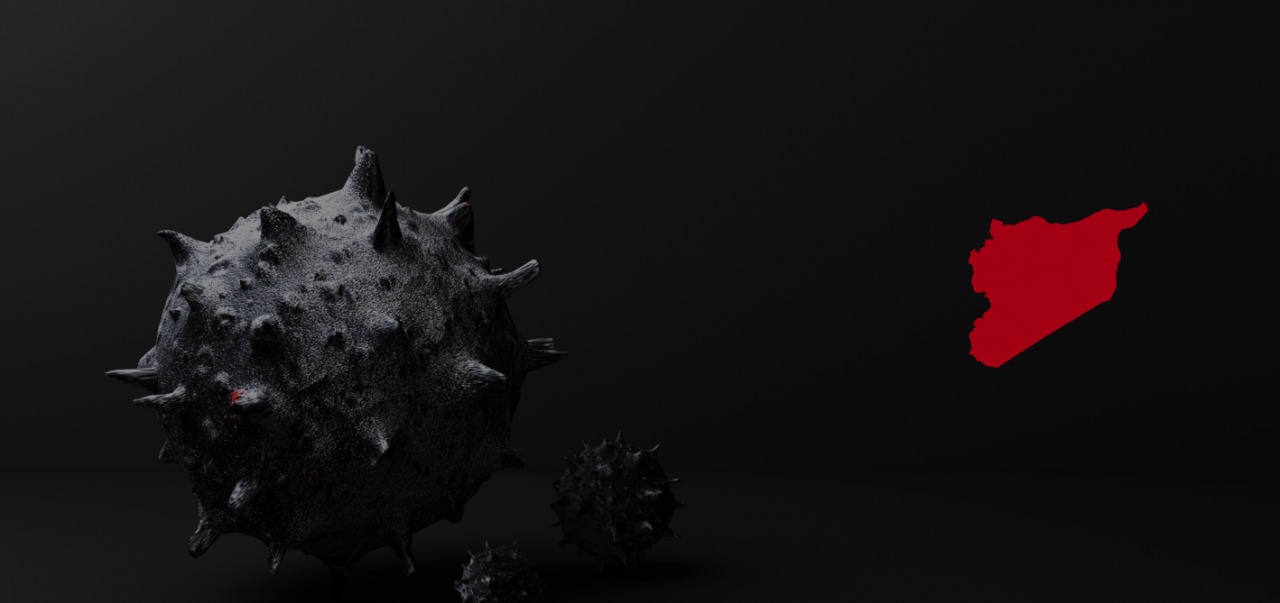COVID-19: Syria in Refugee Camps. Maryam has 15 boys, one girl, and 18 grandchildren. She has lived with her family in Ahl al Qur’an camp in the western countryside of Idlib on the Syrian-Turkish border, ever since she was forced to flee her village in 2015.
On a video call, Maryam narrates the details of her daily routine that has remained unchanged in the times of COVID-19.
She wakes up everyday at dawn before waking the rest of her family, to start preparing for work. Collectively, the family starts preparing food in large quantities sufficient for everyone.
Around 1,000 refugees live in the Ahl al Qur’an camp, and after the recent wave of displacement, the number has increased, according to the camp’s director, Muhammad Sheikh Ismail.
“Here, social distancing and preventive measures recommended by the World Health Organization and other associations are not possible,” he said.
“There are no health or service facilities in the camps, and the number of tents is simply not sufficient for the number of people. Consequently, social distancing and self-isolation is not possible.”
“In each tent (two meters wide and three meters long), there are at least five people who share food and drink, while each section (consisting of 40 tents) has a total of six toilets; three for men and three for women,” Ismail said.
Despite the ongoing threat of the virus, residents felt reassured due to the blockade imposed by the Syrian government, and the Turkish government’s closure of three land crossings: Bab al-Hawa, Safety door, and Jarablos.
Airports and other ports have also been relatively empty since the area’s first recorded case.
However, the severity of the situation evolved after July 9 when the first cases were recorded at Bab Al-Hawa hospital, specifically, in a Syrian doctor who recently moved to Turkey.
There was great fear and concern that the cases would continue to spread due to the absence of preventive measures.
A study carried out by the Medicare Health Foundation, in cooperation with the health directorates in northern Syria, set out to assess the number of potential coronavirus cases, and found that the possibility for widespread infection is extremely high if necessary precautions are not taken.
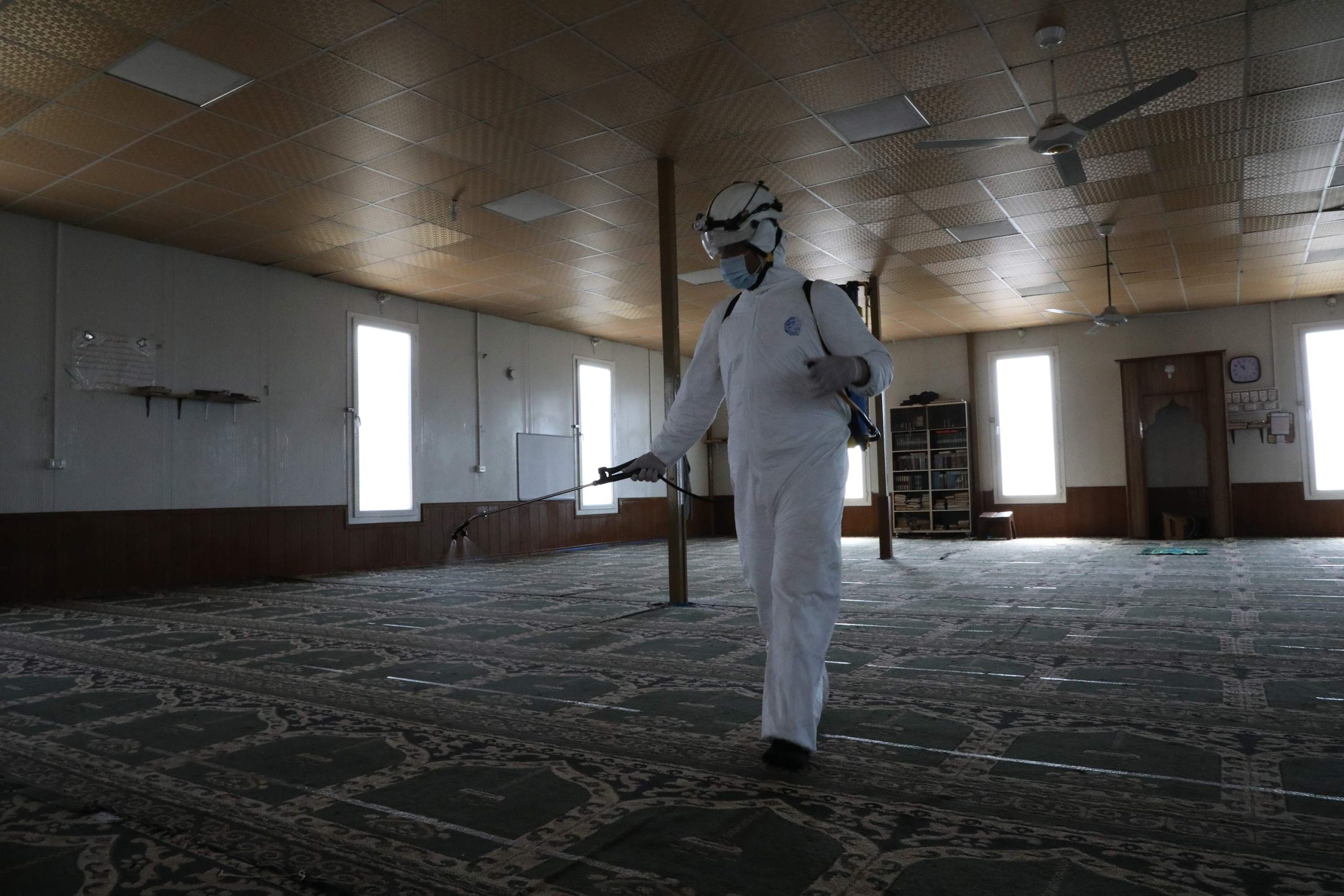
The study indicated that in the first six weeks, cases may reach up to 240,000 (which represent 20% of the internally displaced population), of which 36,000 would be severe, 12,000 would be critical and 14,328 would be fatal.
These areas mostly rely on preventive measures implemented and funded by civil societies and organizations that are already limited in their capabilities and resources.
Director of Latakia (with jurisdiction over the Ahl al-Qur’an Camp) in the Syrian Civil Defense, Muhammad Haji Asaad, sheds light on some of the preventive measures that have been implemented.
“From late April to early September we sterilized 115 camps distributed from Al-Zouf to the village of Badama, including the Ahl al Qur’an camp.
We also sterilized approximately 22 villages in the western countryside of Idlib, and targeted areas with high population densities,” he said.
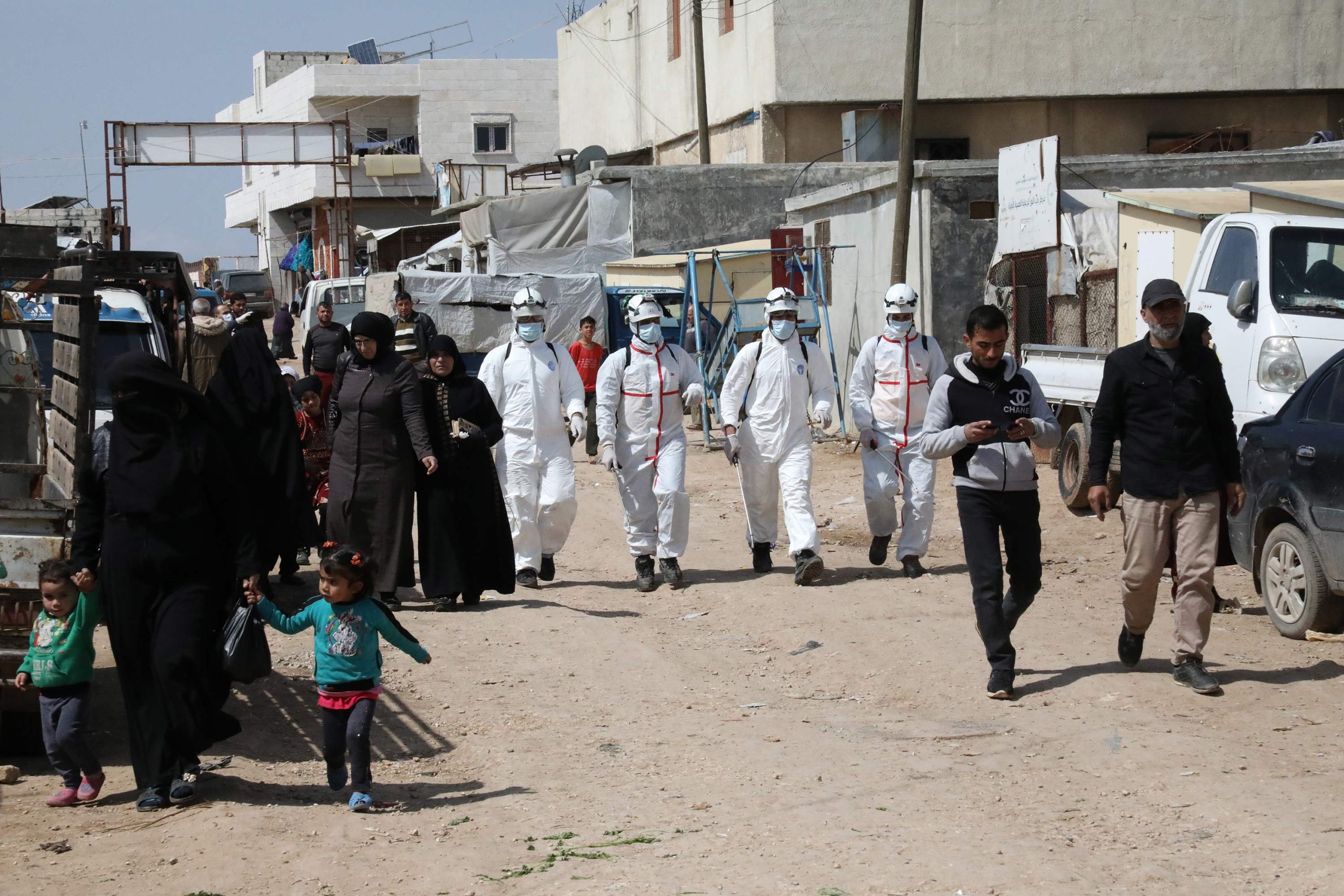
Dr. Mahmoud al-Hariri, the director of the health information unit in northern Syria (including Hama, Aleppo, the Sahel and Idlib) who works directly with the WHO, told ARIJ that, “[Until September], we only had one laboratory in Idlib equipped with tools for analyzing samples.
It was proposed to equip two new laboratories; one in the city of Jarablus [northeast of Aleppo] and the second in the city of Afrin [north of Aleppo]. Some of the equipment has arrived, albeit late, and included 6,0000 analysis kits and tests, which will be activated very soon.”
Dr. Muhammad Al-Salem, director of the vaccine program and member of the Early Warning and Epidemic Response Network, says that “1,390 tests were conducted for suspected cases by the end of June, all of which were negative.”
According to Al-Salem, the lab in Idlib analyses results from various areas and is not restricted to the governorate alone. Samples collected from Deir Ezzor, Raqqa, Aleppo and Hasaka were analyzed in Idlib, he told ARIJ.
The ACU runs the only laboratory in the opposition-controlled areas of northern Syria. According to Al-Salem, the protocol for positive tests is as follows: in the event of a positive result, a second swab is taken from the potential patient and transferred to Turkey for confirmation.
The confirmation is typically provided 24 hours after the test is conducted. As for the hospitals directly supported by Turkey and located in the northern and northeastern countryside of Aleppo, samples are collected there and then sent to Turkey.
Just two days after the first COVID-19 case was recorded in opposition-controlled areas, specifically on July 11, the Ministry of Health of Syria’s interim government announced that the number of cases had risen to three – two of which belonged to doctors working in the Azaz City Hospital who had recently entered from Turkey.
As of 23 July, the number of confirmed cases had risen to 22 out of 3,111 tested, according to Dr. M. Ram Al-Sheikh.
On September 5, the Early Warning Network announced an additional 14 recorded cases — the highest since the pandemic reached the north, bringing the total number of cases to 112.
The accelerated rate at which COVID-19 cases were being recorded, only increased fears in light of already extremely difficult living conditions.
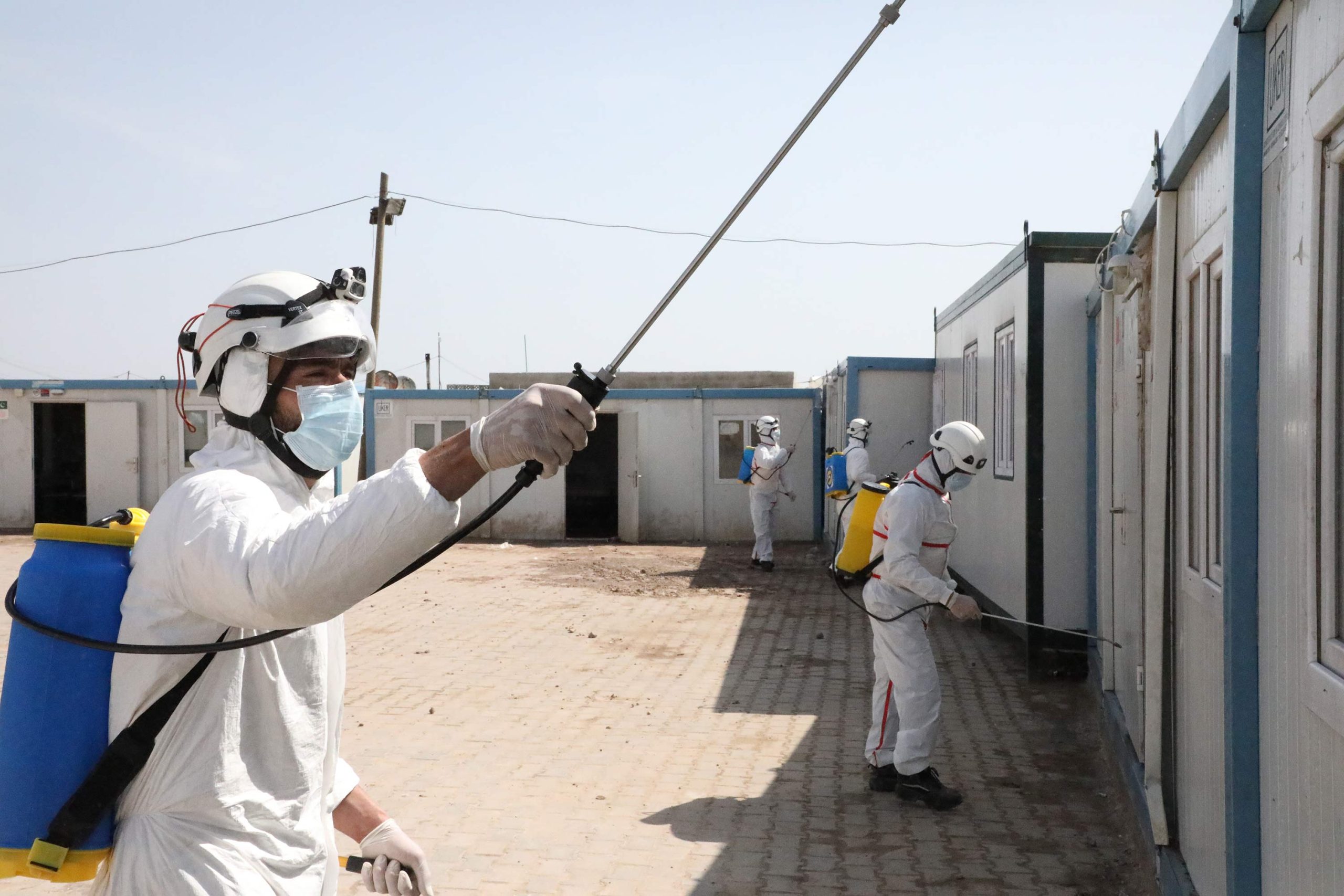
An Exhausted Medical Sector
“Currently, Northern Syria does not have a unified health system, and only a few limited health institutions are operating at maximum capacity to fulfil the needs of more than 4 million people in an unstable and unprepared area,” says Dr. Yasser Najeeb, Executive Director of an Immunization Group in Syria.
The group consists of a medical team that provides vaccines for children under the supervision of the WHO, and is one of several working to tackle the crisis in northern Syria, with support from the WHO.
The ARIJ reporter attempted to contact Dr. Munther Khalil, the Director of the Idlib Health Directorate and responsible for coordinating medical support in the governorate, who did not respond.
Al-Salem describes the medical sector as “exhausted”.
“In northern Syria, there are only 600 doctors serving over 4 million people, a third of which live in overcrowded camps on the border with Turkey. We need at least four times the current number of doctors, and qualified laboratory technicians are very rare. Moreover, the infrastructure has been completely destroyed, and most of the hospitals currently operating are relatively rudimentary,” he told ARIJ.
Dr. Mahmoud Al-Hariri added that, “we fear there will be a great number of casualties among medical staff. As of September 8, we recorded 10 cases among the medical teams, which forced them to remain in isolation for 15 days. For us, it is a big problem for a doctor to be absent throughout this period in light of their scarcity.”
There are only 90-100 respirators available in the entire northern region of Syria, which are meant to serve 4 million people in normal conditions, excluding the pandemic and warzones. Of the total number of respirators, 80 to 85 devices are already being used around the clock, according to Al-Salem, leaving only a few devices available.
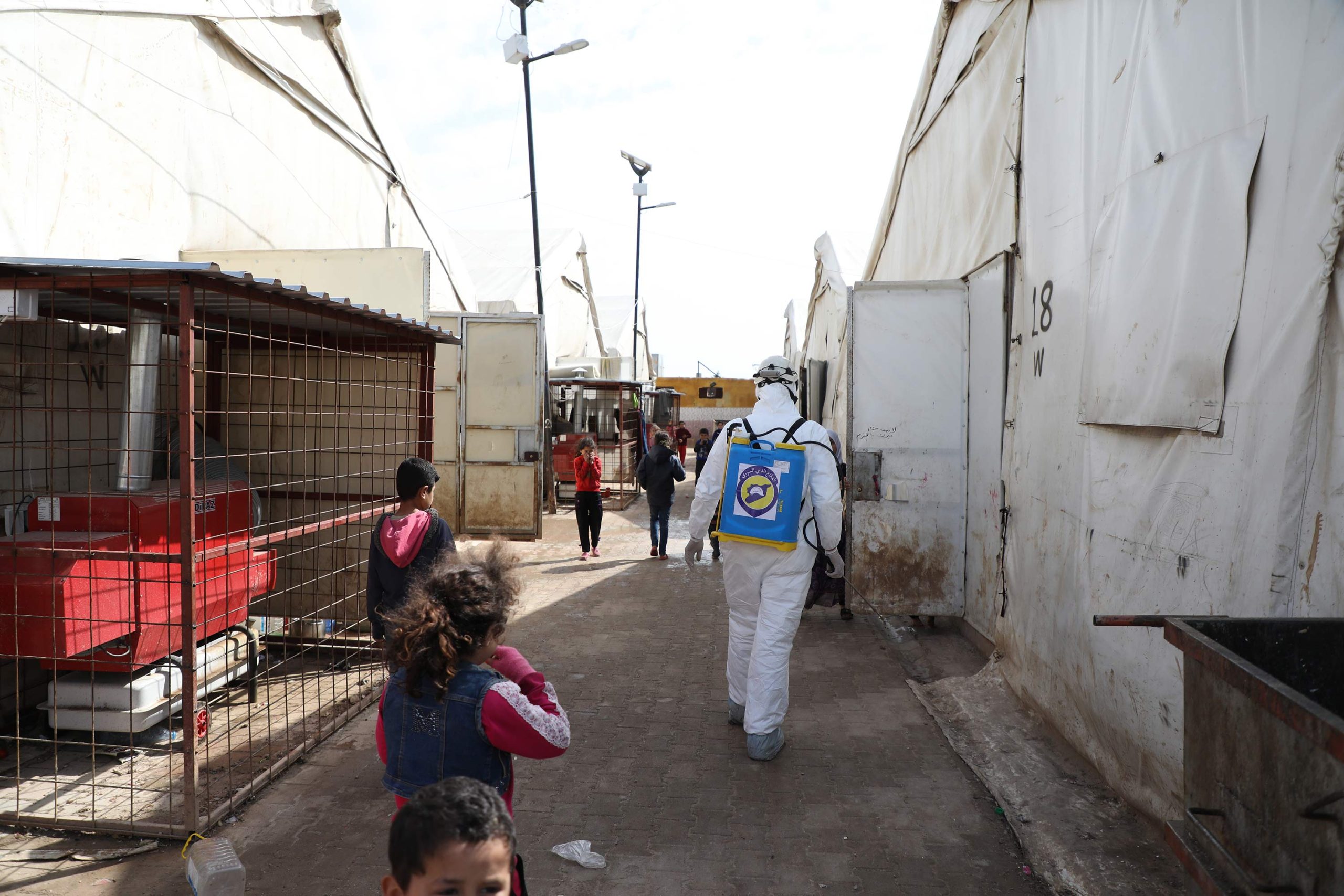
In its 2019 annual report, the Syrian Network for Human Rights documented the death of 26 medical personnel and a total of 98 attacks on medical facilities in that year alone. The attacks were also confirmed in a report by Physicians for Human Rights, which recorded 595 attempted attacks on 350 separate medical facilities, with a death toll of 923 medical workers between March 2011 and February 2020.
According to Dr. Hariri, the WHO has formed a working group, under its direct supervision, for local organizations to confront the pandemic since March.
The group operates in coordination with health directorates, and has a budget of $64 million for a period of six months.
Al-Salem also indicated that Global Health provides safety equipment for workers in the medical sector, and more is scheduled to be sent in the coming period. It has also provided both online and in person training for medical personnel.
“Only four quarantine centers were equipped out of 30. Additionally, just four out of nine hospitals were equipped according to the medical plan initially drafted by medical organizations, with the support of the WHO, to confront the virus,” Al-Salem added.
Local Organizations
According to Mustafa Al-Hassan, the Protection Coordinator at the Sadad Humanitarian organization, the United Nations Office for the Coordination of Humanitarian Affairs (OCHA) allocated $11 million to support response projects, increase hygiene in the camps and support the water and health sector.
It later announced a $75 million grant that would be allocated to organizations, subject to the OCHA’s approval, and according to their projects and plans. These funding figures have been confirmed and matched by three independent sources, but have not been published by the OCHA itself.
For Al-Hassan, “the problem is that most of the organizations working in the humanitarian field in northern Syria are not committed to pandemic prevention measures, and only a few are implementing the appropriate safety and awareness measures amongst their staff.”
Dr. Hariri insists that “no health system is capable of confronting the pandemic without a societal commitment to preventive measures, which is why it is imperative to equip hospitals and isolation centers.
For example, the cost of equipping an intensive care bed can reach up to $13,000 while the cost of a mask is less than half a dollar, and it provides a large amount of protection and largely reduces the risk of infection.”
“However,” he continued, “the majority of the public does not comply with these simple preventative measures. We have even spotted some health sector workers who are not committed to wearing masks.”
The ARIJ reporter found numerous instances of aid organizations not adhering to minimal preventative measures, such as masks.
Beyond the social media accounts of these organizations, which show staff in masks and adhering to the minimal standards, most of the fieldwork is conducted without the necessary health and safety precautions.
Director of the Maram Relief and Development Organization, Yaqzan al-Shishakli, indicated that since last April, his organization has established an isolation and quarantine center in the village of Sheikh Bahr in the countryside of Idlib.
The center provides services to those affected by COVID-19 in a well-equipped arena, to ensure that the virus is not transmitted. Al-Shishakli said that as of September 1, the center has not received a single case.
“The center has a capacity of 160 people and is designed to double its size within a week in the event of an increase in cases, to accommodate 320 people. The center also aims to relieve pressure on local hospitals and coordinates with Idlib Health so that their work is under their supervision,” Al-Shishakli told ARIJ.
Al-Shishakli confirms that his organization has provided several training sessions and workshops on safety and prevention measures, and that the organization has shifted the schools they supervise to e-learning, especially since most of the schools in northern Syria have completely shut down.
“We tried to complete the school year with our 4800 students online, and deliver all the lessons through WhatsApp. However, we faced some accessibility issues, because some families did not have access to WiFi and blackouts meant that the internet was not particularly reliable,” he added.
Chaos and Clashing Authorities
In a region dominated by chaos and lawlessness, the authorities and military organizations seek to gain from the COVID-19 crisis without considering the dangers and consequences of a virus spread.
All decisions aimed at preventing the spread of the virus and issued by the Salvation Government (loyal to the Al-Nusra Front) which manages the city of Idlib and some parts of its countryside, have been superficial, according to Muhammad Haj Hammoud.
Hammoud, a Syrian journalist and Director of the Idlib Plus network, explains how efforts by the authorities are ultimately driven by ulterior motives. Specifically, authorities aim to use this crisis to strengthen their influence “on the ground” and narrow their grip and power over civilians.
This investigation monitored a number of decisions that have effectively put civilians’ lives in danger.
For example, the decision taken on April 2 to suspend Friday prayers in mosques lasted just two weeks. This was a major issue, especially given the month of Ramadan and the increased amount of prayers in local mosques, which continued despite the ongoing crisis and in the absence of any preventative or precautionary measures.
Then, on May 31, came the decision to grant exemptions for vehicle registration fees within a period of 15 days, “with the aim of encouraging people to go back to normality”.
This resulted in citizens flocking to register their vehicles, causing severe congestion, and forcing the government to extend the initial grace period.
This also led to an increase in the risk of contracting COVID-19. Here, the authorities are criticized for attempting to “return to normality” when their interests are clearly focused on remedying the financial deficit and issues with their treasury, instead of prioritizing people’s lives and their safety.
Furthermore, no decision was issued to limit commercial or industrial activity in the governorate. Instead, the Salvation Government tried to open new crossings and trade routes, which threatened the isolation of Idlib and put it at risk of infection from neighbouring areas.
According to various sources (from the Ministry of Health and other unofficial sources), as of June, the neighboring areas had already recorded at least 204 cases. This is despite numerous warnings from the Doctors’ Union in Northern Syria regarding the dangers of opening these crossings.
On April 15, the Headquarters for the “Liberation of Al-Sham” announced the opening of a commercial crossing with areas near the city of Saraqib, due to pressure from the business owners and traders trying to compensate for their losses after the crossings with Turkey were closed. However, the authorities stood to gain from taxes imposed on all vehicles using the crossing, in either direction.

Demonstrations quickly spread in northern Syria, and several popular parties issued statements rejecting the decision and demanding that the crossing be closed. In response to the protests, the authorities simply opened a crossing in a different area in the western countryside of Aleppo on April 30.
Tahrir al-Sham published a video of the crossing’s activities and the entry of trucks from regime-controlled areas. Once again, the people protested by organizing a sit-in to express their opposition to the authorities’ decision. However, the authorities retaliated by shooting at protestors, killing some.
A worker in a local organization speaking on the condition of anonymity, indicates that “the most dangerous thing for humanitarian organizations operating in the northern regions is the interference of the Government through the Office of the Displaced Administration and the Office of Organizations Affairs.
It would be impossible for an organization to operate in those areas or in the camps without their approval, and obstructing these organizations prevents aid from reaching those who need it.”
Due to deteriorating economic conditions, the collapse of the Syrian currency, the threat of the pandemic, and the implementation of the Caesar Act, the suffering and needs of civilians have increased, thereby increasing their dependence on relief and humanitarian organizations.
Ahmed Abdel Hakim, a displaced person who lives in a camp on the Syrian-Turkish border in the western countryside of Idlib, explains how the aid he receives is crucial in sustaining him and his family.
He told ARIJ that if the aid provided to him is cut for just one month, he and his family face starvation and food insecurity, as he is unemployed and without a source of income.
On July 11, after great difficulty, the UN Security Council voted on Resolution No. 2533, which stipulates the renewal of the mechanism for the introduction of cross-border humanitarian aid, specifically through the Bab al-Hawa border crossing that connects northern Syria and Turkey, for a period of one year.
The resolution also called on the UN Secretary General to submit their report on the functioning and progress of the aforementioned mechanism to the Security Council at least once every 60 days.
This investigation was completed with support of Arab Reporters for Investigative Journalism (ARIJ).
SIRAJ —Syrian Investigative Reporting for Accountability Journalism
